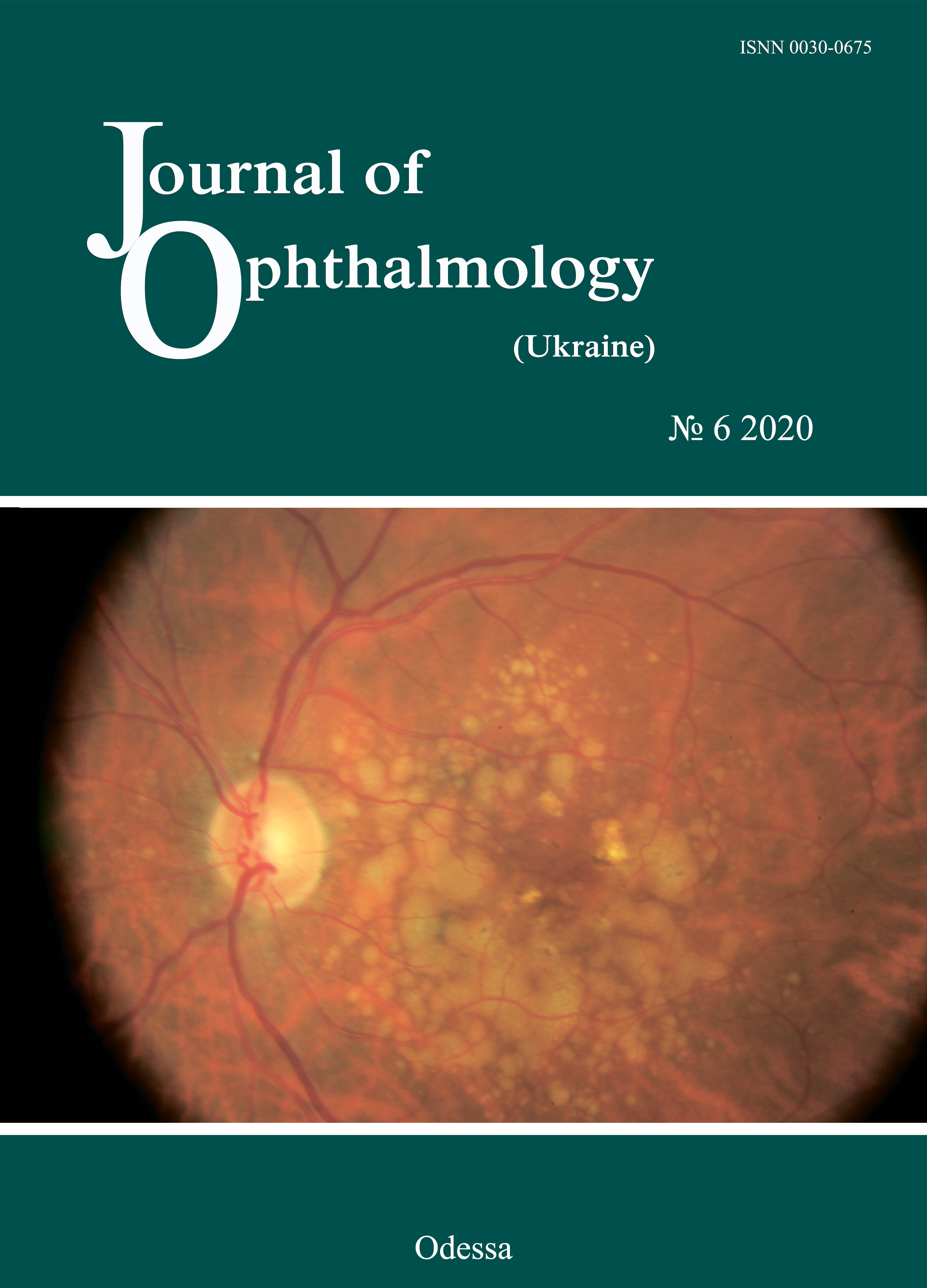Late ultrastructural changes in the rat chorioretinal complex following injection of mixture of 40% ethanol and 100% methanol
DOI:
https://doi.org/10.31288/oftalmolzh202062529Keywords:
ultrastructure, degenerative changes in the cells of the chorioretinal complex, choriocapillaries, retinal pigment epithelium, toxic effect of ethanol and methanol mixtureAbstract
Background: Consumption of surrogate alcohol containing methanol may result in blindness and even death. The literature is scant on experimental and especially morphological studies on the effect of surrogate alcohol containing methanol and ethanol on organs (particularly, the eye) and tissues of experimental animals.
Purpose: To examine late ultrastructural changes in the interplay of cells of the rat chorioretinal complex (endothelial cells of the choriocapillaries, retinal pigment epithelium (RPE) cells, and photoreceptor cells) following a single intraperitoneal (IP) injection of alcohol mixture (40% ethanol and 100% methanol) at the proportion of 3:1, with a methanol dose of 2.5 g/kg.
Material and Methods: Twelve adult Wistar rats (weight, 250-300 g) were divided into two groups, each of 6 rabbits. Group 1 (the experimental group) received a single IP injection of alcohol mixture (40% ethanol and 100% methanol) at the proportion of 3:1, with a methanol dose of 2.5 g/kg, whereas group 2 (controls) received a single IP injection of 100% methanol at a dose of 2.5 g/kg. The LD50 value for IP administration of methanol in rats is reported as 9.5 g/kg body weight. The ultrastructure of endothelial cells of the choriocapillaries, RPE cells, and photoreceptor cells was examined on a PEM-100-01 Transmission Electron Microscope (Selmi, Sumy, Ukraine) at 1 and 3 months after IP injection of the above alcohol mixture in rats.
Results: At one month after IP injection of the alcohol mixture, the lumen of the choroidal capillaries and ground substance of the Bruch’s membrane appeared osmiophilic, indicating increased lipid levels. In most choroidal capillaries, endothelial cells exhibited signs of hydropic degeneration. The RPE cells showed polymorphic changes; some of them showed severe degeneration of organelles, sometimes with total loss of cytoplasm and damage to the plasmalemma at the basal and apical surfaces; some other RPE cells showed signs of compensatory and restorative processes aimed at intracellular repair processes. There were signs of intercellular and intracellular edema and degeneration of membrane structure in the photoreceptor cell layer. At 3 months after IP injection of the alcohol mixture, signs of hydropic degeneration in the examined structures of the chorioretinal complex were somewhat less severe than at the previous time point. A long-term toxic effect of consuming a small dose of methanol was characterized by severe pathologic changes in and poor reserve potential of the cells of the chorioretinal complex, which was reflected in slow repair processes during the period from 1-month to 3-month time points. This likely explains the reported cases of a prolonged serious condition of individuals after consuming surrogate alcohol.
Conclusion: A single IP injection of the alcohol mixture with a methanol dose of 2.5 g/kg body weight resulted both in signs of hydropic degeneration and slow repair processes in the cells of the rat chorioretinal complex during the period from 1-month to 3-month time points. A single IP injection of pure methanol (2.5 g/kg) resulted in uniform and more severe changes in the cells of the rat chorioretinal complex. Methanol can be attributed a leading role in the development of pathological changes in the examined structures of the chorioretinal complex after injection of the alcohol mixture.
References
1.Zabrodskiĭ PF. [Immunotoxicological characteristics of methanol. Correction of immune system dysfunction]. Saratov; 2013. 241 р. Russian.
2.Manuchehri AA, Alijanpour E, Daghmechi M, et al. A case of methanol poisoning leading to prolonged respirator dependence with consequent blindness and irreversible brain damage. Caspian J Intern Med. 2015;6 (3):180-3.
3.Rajamani R, Muthuvel A, Senthilvelan M, Sheeladevi R. Oxidative stress induced by methotrexate alone and in the presence of methanol in discrete regions of the rodent brain, retina and optic nerve. Toxicol Lett. 2006 Sep 10;165(3):265-73. https://doi.org/10.1016/j.toxlet.2006.05.005
4.Sweeting JN, Siu M, McCallum GP, et al. Species differences in methanol and formic acid pharmacokinetics in mice, rabbits and primates. Toxicol Appl Pharmacol. 2010 Aug 15;247(1):28-35. https://doi.org/10.1016/j.taap.2010.05.009
5.Zhai R, Zheng N, Rizak J, Hu X. Evidence for Conversion of Methanol to Formaldehyde in Nonhuman Primate Brain. Anal Cell Pathol (Amst). 2016;2016:4598454.https://doi.org/10.1155/2016/4598454
6.Molchaniuk NI. [Light and electron microscopic study of choriocapillaries, pigment epithelium and photoreceptor cells of rat retinas in dynamics after administration of various doses of methanol]. Visnyk Kyivskogo natsional'nogo universitetu imeni Tarasa Shevchenka. Problemy reguliatsii fiziologichnykh funktsii. 2015;1(18):74-8. Ukrainian.
7.Molchaniuk NI. [Ultrastructural changes in the rat choroid and retina after injection of alcohol mixture (40% ethanol and 100% methanol)]. Visnyk Kyivskogo natsional'nogo universitetu imeni Tarasa Shevchenka. Biologiia. 2019;79:16-24. Ukrainian.
8.Zabrodskiĭ PF, Germanchuk VG. [Effect of ethanol on methanol immunotoxicity]. Eksp Klin Farmakol. 2001 Sep-Oct;64(5):40-2. Russian.
9.Pohanka M. Toxicology and the biological role of methanol and ethanol: current view. Biomed Pap Med Fac Univ Palacky Olomouc Czech Repub. 2016 Mar;160(1):54-63.https://doi.org/10.5507/bp.2015.023
10.Akimov PА, Orbidans АG, Terekhin GА, Terekhina NА. The influence of acute alcohol intoxication on glycogen content in the liver and skeletal muscles. Patol Fiziol Eksp Ter. 2010; 2:15-17. Russian.
11.Patra M, Salonen E, Teramaetal E. Under the influence of alcohol: the effect of ethanol and methanol on lipid bilayers. Вiophys J. 2006 Feb 15;90(4):1121-35.https://doi.org/10.1529/biophysj.105.062364
12.Golovenko NIa, Larionov VB, Ovcharenko NV, Borisiuk IIu, Lihota ЕB. [Toxic-kinetic interaction of ethyl and methyl alcohol in white mice]. Sovremennyie problemy toksikologii. 2008;(1):32-6. Ukrainian.
13.Molchaniuk NI. [Effect of alcohol mixture (40% ethanol and 100% methanol) on the ultrastructure of the rat choroid and retina]. Visnyk problem biologii i meditsiny. 2019;4(1):222-7. Ukrainian.https://doi.org/10.29254/2077-4214-2019-4-1-153-224-227
14.Molchaniuk NI. [Ultrastructure of rat hepatocytes in the early stages after intraperitoneal methanol injection]. Bukovynskyi medychnyi visnyk. 2013; (4):100-3. Ukrainian.
15.Ostrovskii MA, Feldman TB. [Chemistry and molecular physiology of vision, light-sensitive protein rhodopsin]. Uspekhi khimii. 2012; 81(11):1071-90. Russiаn.https://doi.org/10.1070/RC2012v081n11ABEH004309
16.Paasma R, Hovda KE, Jacobsen D. Methanol poisoning and long term sequelae - a six years follow-up after a large methanol outbreak. BMC Clin Pharmacol. 2009 Mar 27;9:5. https://doi.org/10.1186/1472-6904-9-5
Downloads
Published
How to Cite
Issue
Section
License
Copyright (c) 2025 Н. І. Молчанюк

This work is licensed under a Creative Commons Attribution 4.0 International License.
This work is licensed under a Creative Commons Attribution 4.0 International (CC BY 4.0) that allows users to read, download, copy, distribute, print, search, or link to the full texts of the articles, or use them for any other lawful purpose, without asking prior permission from the publisher or the author as long as they cite the source.
COPYRIGHT NOTICE
Authors who publish in this journal agree to the following terms:
- Authors hold copyright immediately after publication of their works and retain publishing rights without any restrictions.
- The copyright commencement date complies the publication date of the issue, where the article is included in.
DEPOSIT POLICY
- Authors are permitted and encouraged to post their work online (e.g., in institutional repositories or on their website) during the editorial process, as it can lead to productive exchanges, as well as earlier and greater citation of published work.
- Authors are able to enter into separate, additional contractual arrangements for the non-exclusive distribution of the journal's published version of the work with an acknowledgement of its initial publication in this journal.
- Post-print (post-refereeing manuscript version) and publisher's PDF-version self-archiving is allowed.
- Archiving the pre-print (pre-refereeing manuscript version) not allowed.












